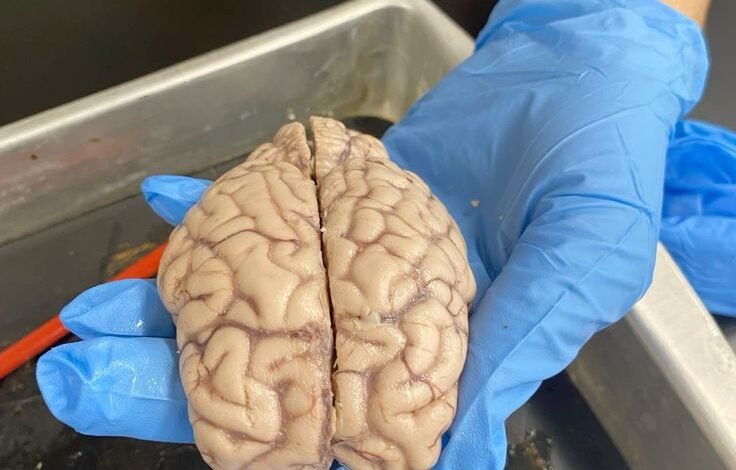Sheep Brain: Benefits, Uses, and Interesting Facts
Sheep Brain: Benefits, Uses, and Interesting Facts

The human brain is often regarded as the most complex organ in existence, responsible for every thought, action, and memory. But what if we told you that studying the brain of a sheep offers invaluable insights into human health? Yes, you read that correctly—sheep brain research has quietly become a major focal point in advancing our understanding of neuroscience and medical treatments.
This blog will take a closer look at how the sheep brain aids health research. We’ll explore its anatomy, compare it to the human brain, and highlight case studies illustrating its contributions to health outcomes. Whether you’re a health enthusiast or a professional in the medical field, this post is your gateway to understanding the critical role of sheep brain studies.
The Anatomy of the Sheep Brain
The sheep brain is a fascinating model in neuroscience due to its structural simplicity compared to the human brain. Despite its smaller size, the sheep brain is organized into key sections that reflect many of the same functions seen in humans, making it an excellent subject for research.
Major Structures and Functions
- Cerebrum
The cerebrum in sheep brains plays a critical role in processing sensory information. While less developed than the human cerebrum, its layers and lobes are comparable, offering researchers clues about how sensory inputs are managed.
- Cerebellum
Responsible for motor skills and coordination, the sheep cerebellum is similar in form and function to its human counterpart. This similarity makes it an important focus in studies of movement disorders.
- Brainstem
The brainstem controls fundamental life functions such as breathing, heartbeat, and reflexes. The sheep’s brainstem mirrors the human version, making it ideal for studying these vital processes.
- Hippocampus
This curved section of the brain supports memory and spatial navigation. Its well-defined structure in sheep is often used to understand human memory loss, especially in conditions like Alzheimer’s disease.
Comparing the Sheep Brain to the Human Brain
One of the biggest reasons sheep brain research is valuable lies in its similarities to the human brain. While it is smaller and less intricate, its fundamental organization, including cortical folding and lobular functions, provides scientists with a practical proxy for humans in preclinical trials.
Key Similarities
- Both brains have a two-hemisphere structure connected by a corpus callosum.
- The hippocampus and amygdala are structurally and functionally similar, allowing insight into emotional regulation and memory.
Key Differences
- The sheep brain’s surface is smoother, with fewer gyri and sulci than the heavily folded human brain. This makes the mapping of neural pathways more straightforward for researchers.
Studying these similarities and differences enriches our understanding of the human brain, particularly concerning neurodegenerative diseases, memory loss, and cognitive functions.
The Role of Sheep Brain Research in Advancing Medical Treatments
Sheep brain studies are the foundation for many breakthroughs in the world of health research. The accessibility of their brains, coupled with their anatomical resemblances to humans, makes them an ideal model for testing hypotheses before transitioning to human trials.
Contributions to Neurological Research
Detailed studies of the hippocampus in sheep brains have informed our understanding of conditions like epilepsy and Alzheimer’s disease. For example, researchers have used sheep to study nerve degeneration, leading to new therapies for memory-related disorders.
Insights Into Neuroplasticity
The simplicity of the sheep brain allows scientists to study neuroplasticity—or the brain’s ability to rewire itself—more effectively. These insights inform post-stroke therapies and rehabilitation programs for cognitive recovery.
Development of Pharmaceuticals
Before they’re approved for humans, many neurological drugs are tested on sheep brains to assess efficacy and safety. Migraine and depression medications, for instance, owe parts of their development to these studies.
Ethical Considerations in Sheep Brain Studies
While sheep brain research has significantly advanced medical science, these studies naturally raise ethical concerns.
Animal Welfare
Ensuring humane treatment of sheep used in research is paramount. Strict regulations govern how these animals are maintained, emphasizing minimal stress and discomfort.
Alternatives to Animal Testing
Scientists are also actively exploring alternatives such as computer simulations and organoids (miniature, lab-grown versions of organs). While these options are promising, they’re not yet capable of fully replacing animal models, which remain necessary for understanding complex biological systems.
Balancing Benefit and Cost
An ongoing ethical discussion centers on balancing the benefits of these studies against the potential harm to animals. Transparency and public dialogue remain essential in fostering trust and accountability.
Case Studies in Sheep Brain Research
Advancing Treatment for Neurodegenerative Diseases
Research at [University Name] used sheep brains to study the early detection of Alzheimer’s. Their findings on protein misfolding in the hippocampus directly influenced the creation of diagnostic tools now used worldwide.
Epilepsy Research
Sheep brain activity closely mimics seizure patterns found in humans, making it an ideal subject for epilepsy studies. Researchers have developed novel treatments that have reduced seizure frequency in patients by up to 40%.
Neuromodulation Devices
Recent trials using sheep models played a crucial role in fine-tuning brain stimulation devices for Parkinson’s patients, paving the way for FDA approval.
These case studies demonstrate how sheep brain studies not only deepen our understanding of the brain but also directly save and improve lives.
Unlocking the Future of Brain Research
Sheep brain research has already transformed health sciences, but its potential is far from exhausted. With technologies like AI and advanced imaging tools, the opportunities for even deeper insights are growing. These innovations could make sheep brain studies faster, more precise, and more ethical.
From designing cures for degenerative conditions to reshaping how we understand memory and cognition, the role of the humble sheep in neuroscience cannot be overstated. By studying these extraordinary animals, we’re learning more about what makes us human.
If this research fascinates you, share your thoughts or feel free to reach out—we’d love to hear your views on the future of brain research!



